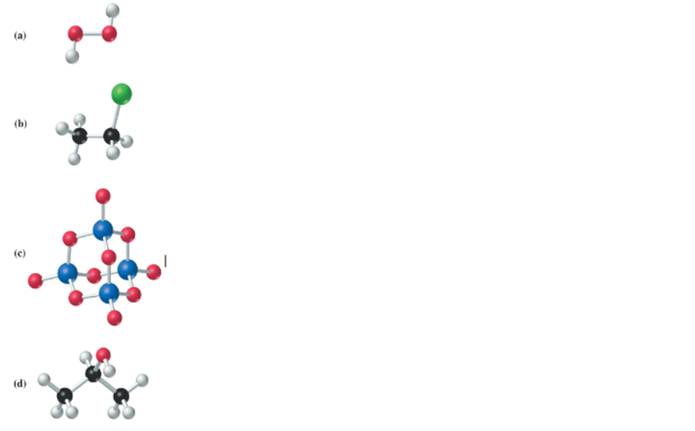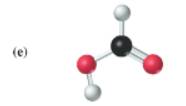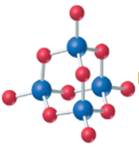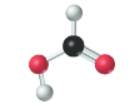
Concept explainers
Refer to the color scheme given Figure 3-3, and give the molecular formulas for molecules whose ball-and-stick models are given here.


(a)
Interpretation:
The molecular formula for the given ball and stick model of the molecule needs to be determined.

Concept introduction:
The ball and stick model of a chemical substance is defined as a molecular model that displays the 3-D position of the atoms and bonds present between them. In the ball and stick model, the atoms are represented as balls or sphere where different atoms are shown by different colors and bonds are represented by sticks drawn between the atoms. The double and triple bonds are shown by drawing 2 and 3 sticks (curved rod) respectively between the atoms.
Answer to Problem 1E
Explanation of Solution
The given structure is as follows:

According to the color scheme given in figure 3.3 in the book, oxygen atom is represented by red sphere and hydrogen atom by white sphere. Thus, there are 2 oxygen atoms bonded together with single bond and 1 hydrogen atom each.
The molecular formula of the molecule will be
(b)
Interpretation:
The molecular formula for the given ball and stick model of the molecule needs to be determined.

Concept introduction:
The ball and stick model of a chemical substance is defined as a molecular model that displays the 3-D position of the atoms and bonds present between them. In the ball and stick model, the atoms are represented as balls or sphere where different atoms are shown by different colors and bonds are represented by sticks drawn between the atoms. The double and triple bonds are shown by drawing 2 and 3 sticks (curved rod) respectively between the atoms.
Answer to Problem 1E
Explanation of Solution
The given structure is as follows:

According to the color scheme given in figure 3.3 in the book, carbon atom is represented by black sphere, hydrogen atom by white sphere and chlorine atom by dark green sphere. Thus, there are 2 carbon atoms bonded together. One carbon atom is bonded with 3 hydrogen atoms and other with 2 hydrogen atoms and 1 chlorine atom.
The molecular formula of the molecule will be
(c)
Interpretation:
The molecular formula for the given ball and stick model of the molecule needs to be determined.

Concept introduction:
The ball and stick model of a chemical substance is defined as a molecular model that displays the 3-D position of the atoms and bonds present between them. In the ball and stick model, the atoms are represented as balls or sphere where different atoms are shown by different colors and bonds are represented by sticks drawn between the atoms. The double and triple bonds are shown by drawing 2 and 3 sticks (curved rod) respectively between the atoms.
Answer to Problem 1E
Explanation of Solution
The given structure is as follows:

According to the color scheme given in figure 3.3 in the book, phosphorus atom is represented by dark blue sphere and oxygen atom with red sphere. Thus, there are 4 phosphorus atoms and 10 oxygen atoms. The molecular formula of the molecule will be
(d)
Interpretation:
The molecular formula for the given ball and stick model of the molecule needs to be determined.

Concept introduction:
The ball and stick model of a chemical substance is defined as a molecular model that displays the 3-D position of the atoms and bonds present between them. In the ball and stick model, the atoms are represented as balls or sphere where different atoms are shown by different colors and bonds are represented by sticks drawn between the atoms. The double and triple bonds are shown by drawing 2 and 3 sticks (curved rod) respectively between the atoms.
Answer to Problem 1E
Explanation of Solution
The given structure is as follows:

According to the color scheme given in figure 3.3 in the book, carbon atom is represented by black sphere, hydrogen atom by white sphere and oxygen atom by red sphere. Thus, there are 3 carbon atoms. The 2 carbon atoms are attached with 3 hydrogen atoms each and 1 carbon atom is attached with 2 hydrogen atoms and 1oxygen atom. The molecular formula of the molecule will be
(e)
Interpretation:
The molecular formula for the given ball and stick model of the molecule needs to be determined.
 Concept introduction:
Concept introduction:
The ball and stick model of a chemical substance is defined as a molecular model that displays the 3-D position of the atoms and bonds present between them. In the ball and stick model, the atoms are represented as balls or sphere where different atoms are shown by different colors and bonds are represented by sticks drawn between the atoms. The double and triple bonds are shown by drawing 2 and 3 sticks (curved rod) respectively between the atoms.
Answer to Problem 1E
Explanation of Solution
The given molecule is as follows:

According to the color scheme given in figure 3.3 in the book, carbon atom is represented by black sphere, hydrogen atom by white sphere and oxygen atom by red sphere. The 2 curved rods between 1 carbon and 1 oxygen atom represents the double bond. Thus, there is 1 carbon atom bonded with 1 oxygen atom via double bond, 1 hydrogen atom via single bonds and 1 oxygen atom via single bond which is further attached with another hydrogen atom. The molecular formula of the molecule will be
Want to see more full solutions like this?
Chapter 3 Solutions
GENERAL CHEMISTRY-MOD.MASTERINGCHEM.
Additional Science Textbook Solutions
Brock Biology of Microorganisms (15th Edition)
HUMAN ANATOMY
Laboratory Experiments in Microbiology (12th Edition) (What's New in Microbiology)
Organic Chemistry
Human Biology: Concepts and Current Issues (8th Edition)
General, Organic, and Biological Chemistry - 4th edition
- Polar solutes are most likely to dissolve into _____, and _____ are most likely to dissolve into nonpolar solvents. A. nonpolar solutes; polar solvents B. nonpolar solvents; polar solvents C. polar solvents; nonpolar solutes D. polar solutes; nonpolar solventsarrow_forwardDeducing the Peactants Can the molecule on the right-hand side of this organic reaction be made in good yield from no more than two reactants, in one step, by moderately heating the reactants? ? Δ If your answer is yes, then draw the reactant or reactants in the drawing area below. You can draw the reactants in any arrangement you like. If your answer is no, check the box under the drawing area instead. Explanation Check Click and drag to start drawing a structure. © 2025 McGraw Hill LLC. All Rights Reserved. Terms of Use | Privacy Center Xarrow_forwardDraw all 8 stereoisomers, circling each pair of enantiomer(s)/ mirror image compound(s)arrow_forward
- Bookmarks Profiles Tab Window Help Chemical Formula - Aktiv Che X + → C 11 a app.aktiv.com Google Chrome isn't your default browser Set as default Question 12 of 16 Q Fri Feb 2 Verify it's you New Chrome availabl- Write the balanced molecular chemical equation for the reaction in aqueous solution for mercury(I) nitrate and chromium(VI) sulfate. If no reaction occurs, simply write only NR. Be sure to include the proper phases for all species within the reaction. 3 Hg(NO3)2(aq) + Cг2(SO4)3(aq) → 3 Hg₂SO (s) + 2 Cr(NO3), (aq) ean Ui mate co ence an climate bility inc ulnerabili women, main critic CLIMATE-INI ernational + 10 O 2 W FEB 1 + 4- 3- 2- 2 2 ( 3 4 NS 28 2 ty 56 + 2+ 3+ 4+ 7 8 9 0 5 (s) (1) Ch O 8 9 (g) (aq) Hg NR CI Cr x H₂O A 80 Q A DII A F2 F3 FA F5 F6 F7 F8 F9 #3 EA $ do 50 % 6 CO & 7 E R T Y U 8 ( 9 0 F10 34 F11 川 F12 Subr + delete 0 { P }arrow_forwardDeducing the reactants of a Diels-Alder reaction n the molecule on the right-hand side of this organic reaction be made in good yield from no more than two reactants, in one step, by moderately heating the reactants? ? Δ • If your answer is yes, then draw the reactant or reactants in the drawing area below. You can draw the reactants in any arrangement you like. • If your answer is no, check the box under the drawing area instead. Explanation Check Click and drag to start drawing a structure. >arrow_forwardPredict the major products of the following organic reaction: + Some important notes: A ? • Draw the major product, or products, of the reaction in the drawing area below. • If there aren't any products, because no reaction will take place, check the box below the drawing area instead. • Be sure to use wedge and dash bonds when necessary, for example to distinguish between major products that are enantiomers. Explanation Check Click and drag to start drawing a structure.arrow_forward
- if the answer is no reaction than state that and please hand draw!arrow_forward"I have written solutions in text form, but I need experts to rewrite them in handwriting from A to Z, exactly as I have written, without any changes."arrow_forwardDon't used hand raiting and don't used Ai solutionarrow_forward
 Chemistry: The Molecular ScienceChemistryISBN:9781285199047Author:John W. Moore, Conrad L. StanitskiPublisher:Cengage Learning
Chemistry: The Molecular ScienceChemistryISBN:9781285199047Author:John W. Moore, Conrad L. StanitskiPublisher:Cengage Learning Introduction to General, Organic and BiochemistryChemistryISBN:9781285869759Author:Frederick A. Bettelheim, William H. Brown, Mary K. Campbell, Shawn O. Farrell, Omar TorresPublisher:Cengage Learning
Introduction to General, Organic and BiochemistryChemistryISBN:9781285869759Author:Frederick A. Bettelheim, William H. Brown, Mary K. Campbell, Shawn O. Farrell, Omar TorresPublisher:Cengage Learning Chemistry for Today: General, Organic, and Bioche...ChemistryISBN:9781305960060Author:Spencer L. Seager, Michael R. Slabaugh, Maren S. HansenPublisher:Cengage Learning
Chemistry for Today: General, Organic, and Bioche...ChemistryISBN:9781305960060Author:Spencer L. Seager, Michael R. Slabaugh, Maren S. HansenPublisher:Cengage Learning


